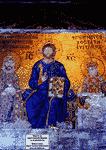icon
, ikonIcon
icon
a person of major social celebrity -notably in film, popular and rock music or sport – who becomes an object of identification, hero worship and emulation. See C. Gledhill, Stardom: Identity and Desire, (1991) London: Routledgeicon
[′ī‚kän]Icon
(language)The central theme of Icon is the generator: when an expression is evaluated it may be suspended and later resumed, producing a result sequence of values until it fails. Resumption takes place implicitly in two contexts: iteration which is syntactically loop-like ('every-do'), and goal-directed evaluation in which a conditional expression automatically attempts to produce at least one result. Expressions that fail are used in lieu of Booleans. Data backtracking is supported by a reversible assignment. Icon also has co-expressions, which can be explicitly resumed at any time.
Version 8.8 by Ralph Griswold <ralph@cs.arizona.edu> includes an interpreter, a compiler (for some platforms) and a library (v8.8). Icon has been ported to Amiga, Atari, CMS, Macintosh, Macintosh/MPW, MS-DOS, MVS, OS/2, Unix, VMS, Acorn.
See also Ibpag2.
ftp://cs.arizona.edu/icon/, MS-DOS FTP.
Usenet newsgroup: news:comp.lang.icon.
E-mail: <icon-project@cs.arizona.edu>, <mengarini@delphi.com>.
Mailing list: icon-group@arizona.edu.
["The Icon Programmming Language", Ralph E. Griswold and Madge T. Griswold, Prentice Hall, seond edition, 1990].
["The Implementation of the Icon Programmming Language", Ralph E. Griswold and Madge T. Griswold, Princeton University Press 1986].
icon
(graphics)Icons are usually stored as bitmap images. Microsoft Windows uses a special bitmap format with file name extension ".ico" as well as embedding icons in executable (".exe") and Dynamically Linked Library (DLL) files.
The term originates from Alan Kay's theory for designing interfaces which was primarily based on the work of Jerome Bruner. Bruner's second developmental stage, iconic, uses a system of representation that depends on visual or other sensory organization and upon the use of summarising images.
IEEE publication.
icon
(1) See Icon language.(2) A small graphic symbol on screen that represents an action or a resource such as an application, file, folder, menu or setting. Clicking or tapping the icon selects the item. On Web pages, icons are also used as a link to other pages (see hypergraphic). See emoji.
Often Overused
When graphics-based interfaces (GUIs) began to replace command lines starting in the mid-1980s, icons were often used without accompanying text. In order to use a program smoothly, users had to memorize the symbols; otherwise, they had to hover the cursor over the icon and wait a couple seconds for a text explanation to hopefully appear. Even today, software designers create interfaces as if users never ran anything but their single application, resulting in myriad hieroglyphics users must remember.
| iPhone Icons |
|---|
| Apple popularized the smartphone interface and prudently set an example of icons and text used together. |
Icon
in the Christian religion (Orthodox and Catholic), in a broad sense, a representation of Jesus Christ, the Madonna, or the saints. The church considers icons to be sacred objects of worship. In a narrow sense, an icon is an easel painting that has a religious purpose. In the Catholic Church icons are predominantly sculptural in form; in the Orthodox Church they are images painted on wood.
Initially, the worship of icons was not a part of Christianity. It arose in the second century, flourishing during the fourth century despite the decree of the Council of Elvira of 306, which prohibited images in places of worship. Many of the church fathers spoke out against the worship of icons, and the Iconoclasts asserted that there was no dogmatic basis for this form of worship.
Icons, unlike idols, are not looked upon by the Christian Church as an identical representation of a deity, but as a symbol, mysteriously connected to it. An icon permits spiritual communication with its archetype and entrance into the supernatural world through an object of the real world. In church practice the worship of icons often develops into idolatry, and the material expression of the icon itself (including the paint) becomes the object of worship. Icons, like fetishes, are given magical properties. Believers often attribute specific powers to various icons that depict the same deity in different ways. For example, the icon of the grieving Madonna allegedly wards off sickness, and the icon of the unburnable Madonna protects against fires.
Icon worship helped strengthen the authority of the church and increase its wealth. Icons appear in Lamaism and several other religions.

